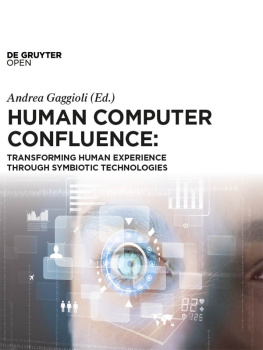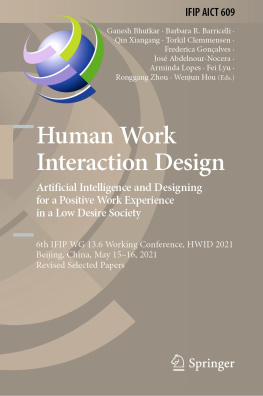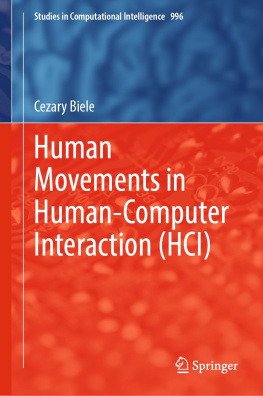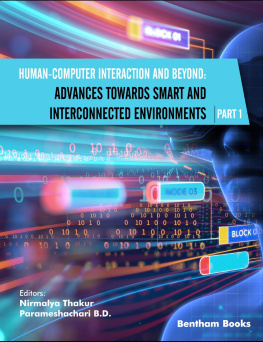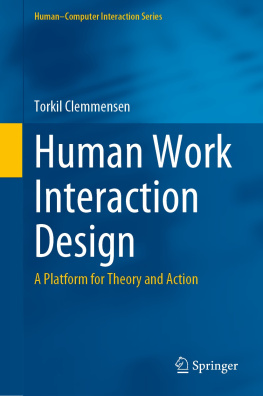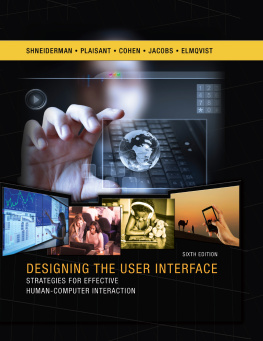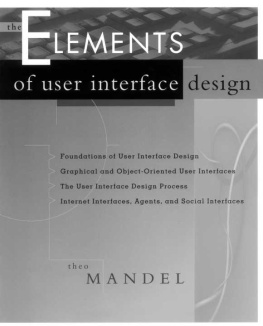About This eBook
ePUB is an open, industry-standard format for eBooks. However, support of ePUB and its many features varies across reading devices and applications. Use your device or app settings to customize the presentation to your liking. Settings that you can customize often include font, font size, single or double column, landscape or portrait mode, and figures that you can click or tap to enlarge. For additional information about the settings and features on your reading device or app, visit the device manufacturers Web site.
Many titles include programming code or configuration examples. To optimize the presentation of these elements, view the eBook in single-column, landscape mode and adjust the font size to the smallest setting. In addition to presenting code and configurations in the reflowable text format, we have included images of the code that mimic the presentation found in the print book; therefore, where the reflowable format may compromise the presentation of the code listing, you will see a Click here to view code image link. Click the link to view the print-fidelity code image. To return to the previous page viewed, click the Back button on your device or app.
Computers as Theatre
Second Edition
Brenda Laurel

Upper Saddle River, NJ Boston Indianapolis San Francisco
New York Toronto Montreal London Munich Paris Madrid
Capetown Sydney Tokyo Singapore Mexico City
Many of the designations used by manufacturers and sellers to distinguish their products are claimed as trademarks. Where those designations appear in this book, and the publisher was aware of a trademark claim, the designations have been printed with initial capital letters or in all capitals.
The author and publisher have taken care in the preparation of this book, but make no expressed or implied warranty of any kind and assume no responsibility for errors or omissions. No liability is assumed for incidental or consequential damages in connection with or arising out of the use of the information or programs contained herein.
The publisher offers excellent discounts on this book when ordered in quantity for bulk purchases or special sales, which may include electronic versions and/or custom covers and content particular to your business, training goals, marketing focus, and branding interests. For more information, please contact:
U.S. Corporate and Government Sales
(800) 382-3419
For sales outside the United States, please contact:
International Sales
Visit us on the Web: informit.com/aw
Library of Congress Cataloging-in-Publication Data
Laurel, Brenda, author.
Computers as theatre / Brenda Laurel.Second edition.
pages cm
Includes bibliographical references and index.
ISBN 978-0-321-91862-8 (pbk. : alk. paper)
1. Human-computer interaction. 2. User interfaces (Computer systems) I. Title.
QA76.9.H85L38 2014
004.019dc23
2013026412
Copyright 2014 Pearson Education, Inc.
All rights reserved. Printed in the United States of America. This publication is protected by copyright, and permission must be obtained from the publisher prior to any prohibited reproduction, storage in a retrieval system, or transmission in any form or by any means, electronic, mechanical, photocopying, recording, or likewise. To obtain permission to use material from this work, please submit a written request to Pearson Education, Inc., Permissions Department, One Lake Street, Upper Saddle River, New Jersey 07458, or you may fax your request to (201) 236-3290.
ISBN-13: 978-0-321-91862-8
ISBN-10: 0-321-91862-2
Text printed in the United States on recycled paper at RR Donnelley in Crawfordsville, Indiana.
First printing, September 2014
For my grandson,
Jem Wade
Foreword
What does a gesture-operated smart device have in common with a Shakespearian play?
No, this isnt a pun, and it isnt a trick question. The answer gets to the heart of this book. Theatre is about interaction, about themes and conflicts, goals and approaches to those goals, frustration, success, tension, and then the resolution of that tension. Theatre is dynamic, changing, always in motion. Our modern technologies with their powerful computers, multiple sensors, communication links, and displays are also about interaction, and treating that interaction as theatre proves to be rich, enlightening, and powerful.
Until recently, computers interacted with people in a stilted, pedestrian manner. Each screen was a static display. Designers and those in the field of human-computer interaction tended to think of each screen as a fixed entity, making sure it was well designed, understandable, and attractive. This is obviously good, but it isnt enough. Real interaction does not take place in the moment, on a fixed, static screen. Real interaction is ongoing over a protracted period. It ebbs and flows, transitions from one state to another. Transitions are as important as states. Until recently, the only computer systems that acted this way were games. But as students of the theatre have long known, we get the greatest pleasure from our ability to overcome early failures and adversaries. If everything runs perfectly and smoothly with no opportunity to deploy our powers and skills, pleasure is diminished. Human emotion is sensitive to change; starting low and ending high is a far better experience than one that is always high. Is this a cry for deliberate placement of obstacles and confusions? Obviously not, but it is a cry for a look at the temporal dimensions, at engagement, agency, and the rise and fall of dramatic tension.
Many years ago I wrote the foreword to the original edition of this book. Years later, I reread it, this time with a broader, richer perspective. The next time I met Brenda, I told her that I finally understood the book. What? she exclaimed in horror. You wrote the Foreword and didnt understand it? No, no, I hastened to reassure her. I understood it then, but now I understand it quite differently. Your book, I told her, was ahead of its time. I thought I understood it when it was written, but I missed some of the most important points, most especially the role of time, change, and a continuing encounter. The book was ahead of its time when it was initially published; please bring it out again, now that the time is ready for you.
Here it is. Im delighted to see it rebornnow, when the time is ripe. The first edition was ahead of its time. This new edition comes at just the right time. Now the world is ready.
What makes the difference?
Both Brenda and I started in the early days of computers, long before computers routinely displayed images on the screen. It was remarkable that computers could do anything at all. As the years passed, the machines got more powerful. We started by controlling them with typed commands, moved from typing to selection through mouse and menus, and finally graduated to the potential for interaction with the entire body, starting with simple gestures, speech, and eye gaze, but for some systems proximity, location, movement, angle of regard, and whole body motion are also relevant. Today, social interactions are the norm, as is the networked interaction of multiple people and systems distributed across the globe. None of this was true in 1991 when the first edition was published.
When I first encountered Brendas ideas, I envisioned them being applied to the formal elements of display screens and the early devices used for interaction. This is a very limited viewpoint. It is better to think of these systems and their programmed applications as a platform, the stage upon which the dramas are enacted. To quote from :


